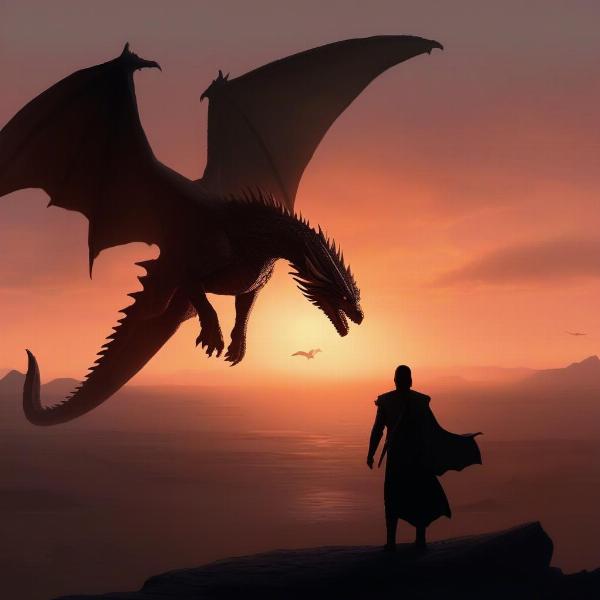The dust settled after the epic battles and devastating losses of Game of Thrones, leaving Westeros dramatically transformed. But what happened next? What became of the shattered kingdoms and the people left to pick up the pieces? This article delves into the potential future of Westeros, exploring the political landscape, the key players, and the challenges they face in rebuilding a world ravaged by war.
Similar to the political turmoil in other fantasy worlds, Westeros faced a difficult path to recovery. With Bran the Broken crowned as king, a new era began, one markedly different from the Targaryen dynasty that preceded it. This transition, however, wasn’t without its complications. The realm was fractured, its resources depleted, and its people weary of conflict. How did this new, fragile peace hold up? What challenges did Bran face in uniting the disparate regions?
The Reign of Bran the Broken
Bran’s ascension to the throne was unexpected, to say the least. Chosen by a council of lords and ladies, his reign signified a departure from traditional hereditary rule. This act, while seemingly progressive, presented its own set of issues. Bran, now known as Bran Stark, King of the Andals and the First Men, Lord of the Six Kingdoms (the North having declared independence), was a ruler unlike any Westeros had seen before. His mystical abilities and detachment from worldly desires positioned him as a figure both revered and enigmatic. Did his unique perspective help or hinder the rebuilding process?
Consolidating Power in a Fragmented Realm
One of Bran’s most significant challenges was unifying the remaining six kingdoms. Years of war had sown deep distrust and animosity between the regions. The Iron Islands, under Yara Greyjoy, maintained their fierce independence, while the Reach, Dorne, the Westerlands, the Stormlands, and the Crownlands each grappled with their own internal struggles. How did Bran navigate these complex political relationships? How did he bridge the divides and foster a sense of shared purpose?
The Small Council: A New Era of Advisors
Bran assembled a small council comprised of both familiar and new faces. Tyrion Lannister served as Hand of the King, bringing his political acumen and strategic thinking to the forefront. Samwell Tarly, Grand Maester, provided scholarly wisdom and a focus on record-keeping. Brienne of Tarth, Lord Commander of the Kingsguard, ensured the king’s safety and upheld the ideals of chivalry. This diverse group played a crucial role in shaping the new Westeros. What were their individual contributions? How did their personalities and perspectives influence Bran’s decisions?
The North’s Independence: A Kingdom Apart
Sansa Stark’s declaration of Northern independence was a pivotal moment in Westeros’s history. After centuries of subjugation, the North finally achieved its long-sought freedom. This bold move set a precedent for regional autonomy and posed a significant challenge to Bran’s authority. Did this division lead to further fragmentation? How did the North’s independence affect the relationship between the remaining kingdoms? You can read more about another prominent Targaryen figure by clicking on this link: how did rhaegar targaryen die in game of thrones.
Rebuilding Winterfell and the North
Under Sansa’s leadership, the North began the arduous task of rebuilding. Winterfell, once a symbol of Northern strength, had been ravaged by war. The surrounding lands, too, bore the scars of conflict. Sansa’s focus shifted from political maneuvering to practical matters: restoring infrastructure, securing food supplies, and fostering a sense of unity among her people. What challenges did she face in leading a newly independent nation? How did the North’s unique culture and history shape its path forward?
The Future of the Dragon Lineage
With Daenerys Targaryen gone, the future of the dragon lineage remained uncertain. Drogon, her last surviving dragon, disappeared, carrying her body to an unknown location. The absence of dragons marked a significant shift in the balance of power. Did their absence create a power vacuum? What impact did it have on the political landscape of Westeros and beyond?
The Search for Drogon and Daenerys’s Legacy
The disappearance of Drogon and Daenerys’s body sparked numerous theories and speculations. Some believed that Drogon had flown east, back to the ancient lands of Valyria. Others hoped that Daenerys might somehow return, resurrected by the magic that had hatched her dragons. These rumors and legends shaped public perception and fueled ongoing debates about Daenerys’s reign and its ultimate impact on Westeros. How did these narratives influence the political landscape? What role did they play in shaping the collective memory of Daenerys Targaryen?
 Drogon flying east with Daenerys
Drogon flying east with Daenerys
Beyond the Wall: New Beginnings?
The lands beyond the Wall, once a desolate and dangerous frontier, underwent a significant transformation after the Night King’s defeat. With the threat of the White Walkers extinguished, the Free Folk began to rebuild their lives, exploring new possibilities for their future. Did this lead to peaceful coexistence with the Seven Kingdoms? Or did new conflicts emerge in the thawing North?
A World Reforged: The Legacy of Game of Thrones
The aftermath of Game of Thrones was a period of immense change and uncertainty. The reign of Bran the Broken, the North’s independence, and the disappearance of the dragons all contributed to reshaping the political landscape of Westeros. While the future remained uncertain, one thing was clear: the legacy of the Game of Thrones would continue to shape the destiny of the realm for generations to come. What do you think the future holds for Westeros? Share your thoughts and theories in the comments below!
Westeros’s Economy: Rebuilding After War
The constant wars had decimated Westeros’s economy. Trade routes were disrupted, crops were destroyed, and entire cities lay in ruins. Rebuilding the economy would be a long and arduous process.
The Faith of the Seven After the Destruction of the Sept of Baelor
The destruction of the Sept of Baelor left a void in the religious life of Westeros. How did the faith recover and evolve in the wake of this devastating event?
The Role of Magic in a Changed Westeros
With the return of dragons and the presence of Bran the Broken, magic once again played a significant role in Westeros. How did this impact the daily lives of the people and the future of the realm?
FAQ
- Who ruled Westeros after Game of Thrones? Bran Stark, known as Bran the Broken, ruled the Six Kingdoms.
- What happened to the North after Game of Thrones? The North declared independence and Sansa Stark became its queen.
- Where did Drogon go after Daenerys died? Drogon flew east with Daenerys’s body, his destination unknown.
- What happened to the Iron Islands? Yara Greyjoy continued to rule the Iron Islands, maintaining their independence.
- Did Westeros ever fully recover from the wars? Rebuilding Westeros would be a long and difficult process, with many challenges along the way.
- What was the significance of Bran being chosen as king? Bran’s reign marked a departure from traditional hereditary rule, representing a new era for Westeros.
- What challenges did Bran face as king? Bran faced the challenge of unifying a fragmented realm and rebuilding trust between the regions.

